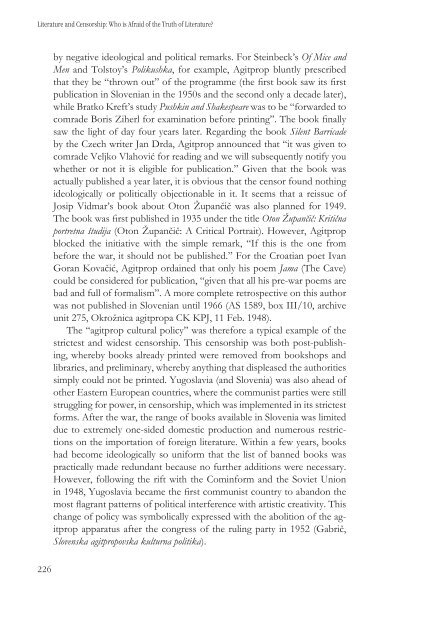Literatura in cenzura - Društvo za primerjalno književnost - ZRC SAZU
Literatura in cenzura - Društvo za primerjalno književnost - ZRC SAZU
Literatura in cenzura - Društvo za primerjalno književnost - ZRC SAZU
- No tags were found...
Create successful ePaper yourself
Turn your PDF publications into a flip-book with our unique Google optimized e-Paper software.
Literature and Censorship: Who is Afraid of the Truth of Literature?by negative ideological and political remarks. For Ste<strong>in</strong>beck’s Of Mice andMen and Tolstoy’s Polikushka, for example, Agitprop bluntly prescribedthat they be “thrown out” of the programme (the first book saw its firstpublication <strong>in</strong> Slovenian <strong>in</strong> the 1950s and the second only a decade later),while Bratko Kreft’s study Pushk<strong>in</strong> and Shakespeare was to be “forwarded tocomrade Boris Ziherl for exam<strong>in</strong>ation before pr<strong>in</strong>t<strong>in</strong>g”. The book f<strong>in</strong>allysaw the light of day four years later. Regard<strong>in</strong>g the book Silent Barricadeby the Czech writer Jan Drda, Agitprop announced that “it was given tocomrade Veljko Vlahović for read<strong>in</strong>g and we will subsequently notify youwhether or not it is eligible for publication.” Given that the book wasactually published a year later, it is obvious that the censor found noth<strong>in</strong>gideologically or politically objectionable <strong>in</strong> it. It seems that a reissue ofJosip Vidmar’s book about Oton Župančič was also planned for 1949.The book was first published <strong>in</strong> 1935 under the title Oton Župančič: Kritičnaportretna študija (Oton Župančič: A Critical Portrait). However, Agitpropblocked the <strong>in</strong>itiative with the simple remark, “If this is the one frombefore the war, it should not be published.” For the Croatian poet IvanGoran Kovačić, Agitprop orda<strong>in</strong>ed that only his poem Jama (The Cave)could be considered for publication, “given that all his pre-war poems arebad and full of formalism”. A more complete retrospective on this authorwas not published <strong>in</strong> Slovenian until 1966 (AS 1589, box III/10, archiveunit 275, Okrožnica agitpropa CK KPJ, 11 Feb. 1948).The “agitprop cultural policy” was therefore a typical example of thestrictest and widest censorship. This censorship was both post-publish<strong>in</strong>g,whereby books already pr<strong>in</strong>ted were removed from bookshops andlibraries, and prelim<strong>in</strong>ary, whereby anyth<strong>in</strong>g that displeased the authoritiessimply could not be pr<strong>in</strong>ted. Yugoslavia (and Slovenia) was also ahead ofother Eastern European countries, where the communist parties were stillstruggl<strong>in</strong>g for power, <strong>in</strong> censorship, which was implemented <strong>in</strong> its strictestforms. After the war, the range of books available <strong>in</strong> Slovenia was limiteddue to extremely one-sided domestic production and numerous restrictionson the importation of foreign literature. With<strong>in</strong> a few years, bookshad become ideologically so uniform that the list of banned books waspractically made redundant because no further additions were necessary.However, follow<strong>in</strong>g the rift with the Com<strong>in</strong>form and the Soviet Union<strong>in</strong> 1948, Yugoslavia became the first communist country to abandon themost flagrant patterns of political <strong>in</strong>terference with artistic creativity. Thischange of policy was symbolically expressed with the abolition of the agitpropapparatus after the congress of the rul<strong>in</strong>g party <strong>in</strong> 1952 (Gabrič,Slovenska agitpropovska kulturna politika).226
















